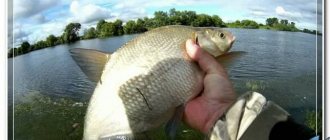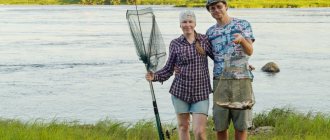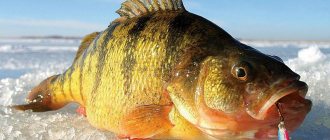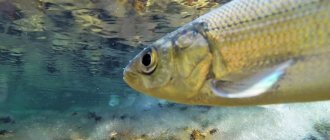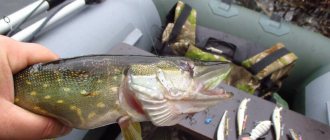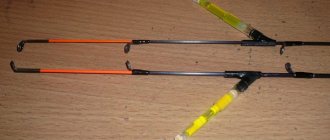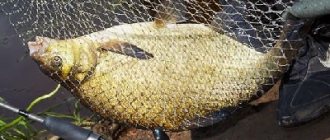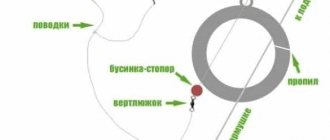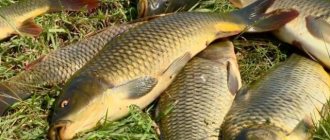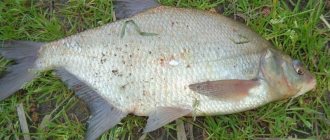Specifics of catching bream
The bream feeds by standing on its head. Prefers worms, bloodworms, dung worms, broom larva or maggots. Among plant baits, it readily takes egg dough, steamed peas, and semolina porridge.
Bream does not like to search for food, but due to the need for large quantities of food, it goes to places with constant food. In reservoirs, it periodically changes its parking places, but does not change its feeding places.
Such places are made at a depth of up to 3 m. This fish is not suitable for shallow water. In deep, muddy places, the bite begins later. It is also necessary to take into account the calorie content of the bait, because the more nutritious it is, the faster the bream will satisfy its hunger.
Where to look for bream in summer?
The water level drops in summer. Bream can no longer be found near the shore during the day. It feeds near its permanent residence.
Fish can be found in calm water, near the bottom in deep pools, in shallows far from the shore with sharp transitions into holes and bays with clay or silty soil, in whirlpools, near steep banks, near thickets of water lilies or on the border of reeds and reeds.
When searching for a fishing spot, examine the coastal vegetation and riverbed. It is also useful to take a walk in the evening and in the morning to notice the “play” of the fish (a splash of water, and before that the appearance of the head, dorsal fin, and, finally, its tail), the appearance of bubbles at the feeding site of the bream.
Fishing methods
You can catch bream in the summer using various methods and gear. The choice of a specific method and equipment options depends on the fishing location and, naturally, on the preferences of the fisherman. In fact, every method of summer bream fishing is effective in skillful hands and when used correctly. Today the most common are:
- Feeder.
- Fishing in the wire.
- Summer ride.
- Onboard fishing rods.
- Match fishing.
- Ring fishing.
- Various bottom gear.
In addition to the feeder, you can also note the float rod. This is more delicate fishing. Catching even a kilogram bream with a fly rod with a thin line is very emotional and vivid. However, float gear is not applicable everywhere. They cannot be fished far from the shore or at depths exceeding the length of the rod. In addition, it is not always possible to cut off the small things that will prevent you from purposefully catching large fish.
As for the fishing rod, fly rods have proven themselves to be excellent. Up to seven meters long. It is very light, so you can hold it in your hands for a long time without straining your arm muscles.
Best time to catch bream
Bream takes bait most actively during the feeding season, which begins in July. At any time of the day, bream overeats, but does not forget to be careful.
How to catch bream in June during the day?
During the day, bream is found in holes and all sorts of depressions, where it looks for food.
How to catch bream in June in the evening?
In the evening, this fish is no longer afraid to approach shallow slopes, and when it starts to get dark, it already goes out onto reaches overgrown with vegetation.
How to catch bream in June at night?
Surprisingly, it is mainly large bream that bite at night. If we compare the bite with the daytime bite, the fish take it more often. At night, the fish goes to the light from the fire, to the cattle watering place, to steep banks, to beaches, piers, shallows and fords, in general, to places with easy food.
During the full moon, the zhor intensifies. There is an opinion among fishermen that on a new moon, bream often runs aground. But in any case, there is no point in throwing bait further than 5–7 meters from the shore.
By morning you can cast 10–15 m from the shore. They fish in absolute silence. To prevent the bait from making splashes, it is sent into the water in a crumbly state. More flavors are added to the bait. To prevent the bait from being washed out, clay is added to it.
Lure
Bait is almost always used to catch bream, and the summer period is no exception. Bait is used both store-bought and homemade, for which there are a lot of recipes.
It is important not to forget that the purpose of bait in this case is simply to attract fish. That is why it should not contain any particularly nutritious components. In general, a significant part of the recipes assumes the presence of semolina and breadcrumbs in the bait, which together form a light spot on the bottom that attracts bream.
Bream bait often contains components such as barley, wheat, corn, beans, cake, and ground bran.
You can also use egg powder or milk powder as part of the bait, which creates small clouds of turbidity in the water, thereby attracting bream. But don’t go too far with the quantity, otherwise you’ll end up with flocks of little things. It is recommended to use no more than 70-100 grams of these additives per 1 kg of bait mixture.
[THERE IS AN ANSWER] How to catch crucian carp in the summer on a feeder?
Important: if you catch bream using grain bait, then grain should not only be part of the bait, but also part of the bait. It is advisable to let the bream get used to this food for several days.
Groundbait mixtures with flavorings show good results. In summer, bream are most attracted to the following aromas:
- Strawberry
- Honey
- Cherry
- Caramel
- Vanilla
- Anise
- Dill
- Garlic
- Cinnamon
- Coriander
Important! This kind of bait is effective in a strong current, which, by animating it with its force, creates the illusion of using a real live bait.
Lures and groundbaits for catching bream
The bait is made from shell meat, boiled potatoes, steamed peas and wheat, thick semolina porridge, worms, and molted crayfish.
Groundbait is made from bloodworms, maggots, vanillin, anise, spices, steamed bran, black bread, various cereals (for example, hominy, rolled oatmeal, oatmeal).
The bait and groundbait are different and not repeated every day. Various flavorings and sugar or honey are added for sweetness. You will have to experiment with the color of the complementary food, because bream in different bodies of water reacts to different colors and tones. It is mainly light brown, white and yellow.
Baits and bait
The range of baits and attachments is simply huge and depends on:
- season;
- water temperature;
- body of water;
- weather.
In the cold season, bream prefers bait of animal origin:
- Worm (preferably dung).
- Bloodworm.
- Sandwich (maggot and bloodworms).
In warm water, fish bite more effectively on plant baits:
How to catch more fish?
I have been active fishing for quite some time and have found many ways to improve the bite. And here are the most effective:
- Bite activator. Attracts fish in cold and warm water with the help of pheromones included in the composition and stimulates its appetite. It’s a pity that Rosprirodnadzor wants to impose a ban on its sale.
- More sensitive gear. Reviews and instructions for other types of gear can be found on the pages of my website.
- Lures using pheromones.
You can get the rest of the secrets of successful fishing for free by reading our other articles on the site.
- Boilies.
- Pearl barley.
- Corn.
- Dough.
Different attachments can be used in combination. If you fish with bloodworms, it is better to bait 4-5 pieces. Because a smaller bait can be eaten, for example, by crucian carp, which also often feeds next to bream. Try to experiment, take several attachments with you in order to find the best option through trial and error.
If you are a beginner angler, it is better to buy ready-made bait in the store. It usually includes the optimal composition. Fruit-flavored baits are better suited. It is also worth taking special glue for them. It will help prevent the bait from being washed away in the river current.
Since each body of water is individual, experienced fishermen prepare their own bait. Let's look at the composition of homemade bait for bream:
- The main ingredient of the bait will be a very nutritious cereal - wheat or pearl barley.
- In addition to the base, you can add something sweet, such as corn or green peas.
- It is advisable to also add an animal supplement: a worm, bloodworm or maggot.
- To collect fish from large areas of the reservoir, you can use flavorings: anise or vanilla.
- All this should be mixed with moist soil. Its humidity depends on the strength of the current.
For each fishing season, you should choose your own scent.
- in the spring, the smell of anise, vanilla or the smell of animal baits is suitable;
- in summer and autumn - different fruit options or the smell of sunflower;
- in winter - very exotic smells of black pepper or pineapple.
Color of bait when fishing for bream:
- Spring and summer - red, orange or green.
- Winter and autumn – black or brown.
The most universal bait color for different periods is red.
How to choose the right bait for bream?
Firstly, it is necessary to remember that bream does not swallow the bait, but sucks it in. Heavily made up hooks simply will not be able to hook a fish.
The bait is chosen according to the preferences of the bream, but it eats various mollusks, crustaceans, larvae, plant shoots and algae.
This means you can use worms, crayfish meat, chafers, dragonflies and their larvae, butterflies, grasshoppers, crickets, mole crickets, frogs and tadpoles, steamed peas, oats, wheat, the crust of a loaf or white bread,
Secondly, when the mayfly (broom, panicle) flies out, this is the second half of June, it is better to use this butterfly. The fish eats itself off, as they say, from its belly, and the bream’s bite stops altogether for several days after this.
Bream biting intensity in summer
The intensity of bream biting during the period of open water in different sections of rivers, lakes, and reservoirs can be divided into several main time periods - spring, summer and autumn.
In the spring, bream are better caught in warm shallows. The intensity of the bite in the spring is due to the fact that bream (like any other fish) intensively fattens up before the upcoming spawning, feeding on high-calorie live food on floods of rivers and lakes.
The next period of time for catching bream is at the beginning of summer. About a week after spawning, the fish begin to really eat. At the beginning of summer, bream are better caught using live baits, although, often, even large bream does not refuse baits of plant origin.
The third period refers to the hottest time period of summer - the July heat - with the worst conditions for stable biting. This period of summer is characterized by weak activity not only of bream, but also of any other fish of the carp family and depends on the weather conditions and time of day. But almost every day of the day the fish spends its time in a long-term habitat in a river hole.
In addition, by the middle of the summer period of the year, many fish of the cyprinid family switch to feeding on young shoots of soft algae, problems with finding which are not observed in most reservoirs, which also affects the intensity of bream biting.
During the hottest period of summer, bream fishing becomes unproductive in the shallows, where the oxygen balance significantly deteriorates due to overheating of the water. Therefore, bream are forced to spend most of the daylight hours in cool, deep holes. It is clear that it is unnecessary to mention any intensity of bream biting in the fish’s long-term resting habitat here.
The best time period of the day for catching bream in the shallows in July - early August corresponds to evening twilight - night - early dawn. For night fishing for bream in the summer, it is better to use moving baits. Although the fish will also smell odorous plant baits.
The fourth period of summer bream fishing corresponds to approximately mid-August. At this time, fish of different breeds begin to intensively prepare for the winter season. Closer to autumn, the bream bite becomes better on high-calorie bulk baits of animal origin.
In the autumn season, bream with varying degrees of activity can be caught during the entire daytime.
How to catch bream in June?
Bream bites on any fishing rod, spinning rod and donka.
Float rod
This type of fishing rod is used for fishing in quiet, important places. The fishing rod is chosen to be elastic and flexible. The main line is 0.18 mm in diameter, and the leash is 0.14–0.16 mm. Buy a friction reel.
Several sinkers are installed to distribute the load evenly. The fishing depth should not exceed 4 m. The nozzle should lie on the bottom, but the sinker was slightly missing from the bottom. Bakery products with the addition of anise or dill are used as an attachment.
Breadcrumbs are added to the bait, but it is better not to use black bread.
On hook No. 5, lumps of dough should be sculpted in the shape of a pear, and maggots and worms should be planted in clusters. A sign of a bite will be the lowering of a vertically standing float on its side. This indicates that the bream stood on its head and sucked in the bait along with the water. After some time, the float will sink, which means you need to make a sharp and short hook, otherwise you can tear the bream’s lips and it will fall off. This fish does not offer resistance until then, and if you give the bream a breath of air, the fish will give up completely.
Wire fishing rod
A light fishing rod is taken with a length of 2.2–2.8 m. The fishing line is chosen to be thin, but the strongest. The float is chosen bright. The sinker consists of three pellets. the first and lightest are placed at a distance of 3 cm from the hook, the next two at a distance of 30 cm from each other and the first.
A “ball” of caddisfly, burdock, maggot, and insect larvae is hooked onto the hook. Biting a bream is similar to another fish swallowing bait. The float suddenly goes under water. At this moment they make a hook.
Bottom fishing rod
In June, it is better to catch bream using a bottom fishing rod. This is due to the fact that it goes deep. Steamed peas, a ball of dung worms or 2-3 maggots are used as bait.
If the donka is used from a boat, then the bait is delivered to the very bottom in a special mesh feeder with a large sinker. If from the shore, then cast in small portions directly to the place where the bottom fishing rod is installed.
The hook is made long and at the slightest vibration of the nod. Fish is caught in such a way as to prevent the line tension from weakening. The fishing line is taken with a diameter of 0.2–0.35 mm. The stronger the current, the thinner the fishing line.
The bottom is equipped with a spring with its own loading. Leashes are made 5–10 cm long from fishing line with a diameter of 0.1–0.2 mm. Attach the leash directly next to the spring.
Reviews from fishermen about catching bream in summer
I caught this giant in the evening, from a boat - I used the simplest nylon cord and hook 5, my bait was corn and maggot. I sat there from morning until evening, but the catch pleased me. Grade:
Timur
I fished for bream on the Volga - it was entertaining and successful, at the beginning of summer. Early in the morning we threw the gear into the creeks, dug up maggots on them in the evening and caught bream. We were happy with the catch - we pulled out about 10 kilograms. Grade:
Nikolai
I can safely call myself an expert in bream fishing - my grandfather and my father caught it in our old creek. I advise all beginners to fish with maggots and sweet corn, and pull with a strong line. True, I take small hooks, but strong ones. This year in the spring I have already caught 50 kilos of bream and small bream, the main thing being bait and a strong hook. Grade:
Ivan
I always went fishing for bream in our shallow backwater - one of my friends suggested this to me. Here there is less resistance from the fish, and even with a flat, gently sloping bottom, everything is clearly visible. As for bait, it is best to fish with live bait, which is taken from the same body of water where Lesh himself lives, in particular earthworms. Grade:
Oleg
I caught bream for the first time this year - I dug up the worms myself and took the maggots from a friend. But I’ll tell you from myself – the smell is still the same, and instead of fishing line you should take not 0.8 fishing line, but a strong cord woven from fishing line. A friend suggested the place to me - it was with him that we caught more than one kilo of bream on the Volga. Grade:
Igor
Note! The key to successful bream fishing consists of several components. At the very beginning it is fishing in the right place, the second is fishing at the right time of day. And, of course, having previously selected the gear - the rest is a matter of skill and technique.
Fishing for bream at great depths and in various currents
At great depths, a wire rod will be of little use. Bream don't like fast moving bait. It is better to use a ring and an undercut. The bait will be bread crumb, peas, a cube of porridge, a few maggots or worms. Don’t rush into hooking. The skill of hooking in strong currents and at depth will come with experience.
There are several rules:
- A well-fed bream will not really grab even small bait.
- The fish grabs a small bait immediately, but a large one first absorbs it.
- At night, bream is less careful than during the day.
Tackle and equipment for catching bream
Typically, long casts are not required to catch bream. The fishing line is suitable 0.1–0.4 mm in thickness, hook numbers 3.4. Tackle: float rod, donka, jig.
- The float rod should be light, quick to set up, 3–5 m long with a light reel. It is possible to use a fly rod up to 7 m in length. For fishing at night, you can use luminous floats.
- Bottom tackle or feeder is from 3 to 4.4 meters in length, the distance between the hook and the sinker is no more than 10 cm. For fishing in deep waters, you can use sliding equipment and other wiring. 50-100 g of dough is used as a feeder. Fishing is successful both in still water and in strong currents.
- Fishing with a jig. It is good to fish with a jig from a boat, in the thickets. The length of the rod with a fast action is from 3 to 3.5 m, the reel is inertia-free. It is not necessary to have a float. Instead of a sinker, you can use large jigs. When fishing in winter, the fishing rod should be equipped with a Mylar plate nod up to 15 cm long and a fishing line thickness of 0.08–0.1 mm. Tungsten jigs are convenient. If there is a current, the following models are also suitable: Drobinka, Grushka, Uralochka.
